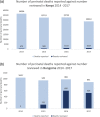Strengthening the "P" in Maternal and Perinatal Death Surveillance and Response in Bungoma county, Kenya: implications for scale-up
- PMID: 31470854
- PMCID: PMC6716884
- DOI: 10.1186/s12913-019-4431-4
Strengthening the "P" in Maternal and Perinatal Death Surveillance and Response in Bungoma county, Kenya: implications for scale-up
Abstract
Background: This paper examines perinatal death reporting and reviews in Bungoma county, Kenya, where substantial progress has been made, providing important insights for wider scale up to other contexts.
Methods: Quantitative methods were used to analyse trends in perinatal death reporting and reviews between 2014 and 2017 throughout Kenya based on data from the District Health Information System. Qualitative methods helped further understand the success of perinatal death reporting and review in Bungoma county through focus group discussions and individual interviews at 5 hospitals and 1 health centre. Thematic analysis was used to draw out codes for the analysis.
Results: Only 13 of the 47 counties in Kenya conduct perinatal death reviews. In 2017, the year after the perinatal death review system was introduced, only 3.6% of perinatal deaths were reviewed in Kenya. Bungoma county has made the greatest strides in Kenya, reviewing 59% of the perinatal deaths that occurred within the county in 2017. Bungoma accounted for 51% of all the perinatal deaths reviewed in Kenya. Factors contributing to the success in Bungoma include harmonisation of facility based perinatal reporting tools with the national level; prioritising the need to document and report mortalities; tailoring continual medical education and supportive supervision visits to needs identified from the review; and better documentation and referral processes. Supportive management and administrative staff have also helped drive forward implementation of actions and increased health staff motivation to reduce perinatal deaths and improve quality of care.
Conclusions: Successful implementation of perinatal death reviews requires clear delineation of roles and responsibilities for action, which are routinely monitored to track implementation progress. As in other low-income settings, Bungoma county has demonstrated that in Kenya, perinatal death reviews can be effectively implemented and sustained, through a focus on learning, solution-oriented responses, influencing those in a power to act, accountability for results, and observable quality of care improvements.
Keywords: Kenya; Maternal and perinatal death review and response systems; Perinatal death reviews; Perinatal mortality.
Conflict of interest statement
The authors declare that they have no competing interests.
Figures
References
-
- Hug L, Sharrow D, Sun Y, Marcusanu A, You D, Mathers C, et al. Levels and Trends in Child Mortality 2017.
-
- National Bureau of Statistics-Kenya and ICF International . Kenya 2014 Demographic and Health Survey Key Findings. 2015. p. 24.
-
- United Nations . Sustainable Development Goals. United Nations. 2015. pp. 1–4.
-
- WHO, UNFPA, UKAID, CDC, E4A, FIGO, et al. Maternal Death Surveillance and Response: Technical Guidance Information for Action to Prevent Maternal Death. WHO; 2013. p. 1–128.
Publication types
MeSH terms
LinkOut - more resources
Full Text Sources
Research Materials



